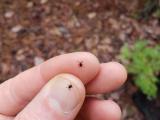Oct 26, 2011
Cantaloupe Listeria outbreak grows by 10 cases, 3 deaths
The total number of US listeriosis cases linked to cantaloupes from Jensen Farms in Colorado has grown by 10 to 133, while 3 outbreak-related deaths have been confirmed, raising the total to 28, according to a CDC update yesterday. The number of affected states has remained the same, 26, since the CDC's last update on Oct 18. The agency is advising consumers to discard any whole or precut Rocky Ford–brand cantaloupe from Jensen Farms and to ask a grocer if unsure of a cantaloupe's origin. The outbreak is the nation's deadliest foodborne disease outbreak in two decades and is compounded by the fact that Listeria monocytogenes, the outbreak strain, has a long incubation period and can reproduce in chilled foods.
Oct 25 CDC update
Study reports cluster of novel bunyavirus cases in China
Six members of a family in eastern China likely contracted a recently identified bunyavirus from another family member, according to a report yesterday in Clinical Infectious Diseases. Chinese scientists detail the case of an 80-year-old woman with fever, low white blood cell count, and low platelet count who died on Apr 27, 2007. Within a week to 10 days another six family members were hospitalized for similar symptoms. Blood samples from all seven were positive for a novel bunyavirus identified in China in March, called severe fever with thrombocytopenia syndrome bunyavirus, or SFTSV. The researchers said the only commonality among the six secondary patients was exposure to the index case, and none had reported exposure to suspected animals or vectors. They conclude, "Epidemiological investigation strongly suggests that infection of secondary patients was transmitted to family members by personal contact."
Oct 25 Clin Infect Dis abstract
Mar 16 CIDRAP News story on SFTSV discovery
German E coli outbreak profile highlights unusual findings
German researchers today published a profile of the Escherichia coli O104:H4 outbreak, which confirmed some of the early observations, including an unusually large percentage of patients with hemolytic uremic syndrome (HUS), a potentially fatal complication. Their findings, based on German surveillance data, clinical information on patients treated at Hamburg University Medical Center, and microbiologic analysis, appear in the New England Journal of Medicine. Germany reported 3,816 cases, including 845 (22%) with HUS and 54 deaths. The report says the outbreak strain combined the virulence properties of Shiga-toxin–producing E coli and typical enteroaggregative E coli; the latter type is isolated primarily from humans, which suggests that the origin of the outbreak may not have been zoonotic. About 22% of patients had HUS, which is much higher than the 6% typically seen in E coli O157:H7 surveillance, the authors note. Though the majority of HUS cases were in adults, the number of children affected (101) was surprising, given that the outbreak strain lacked an intestinal adherence factor that has rarely been isolated in children with HUS. The group also confirmed that the estimated incubation period, at 8 days, was longer than the 3- to 4-day period seen in E coli O157:H7 infections. In addition, clinical data showed that adults were more likely to have bloody diarrhea and children were more likely to have vomiting.
Oct 26 N Engl J Med abstract

















